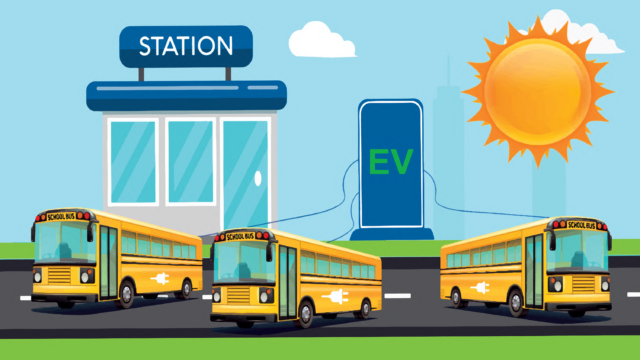The Route to Electric Buses: What K-12 School Districts Need to Know

In April 2022, the New York State Legislature passed a budget to transition school bus fleets to 100% electric vehicles (EV) by 2035. The legislation also requires the purchase of new school buses to be completely electric starting in 2027.
With roughly 50,000 school buses across New York State, the legislation poses challenges for school districts to consider when planning for such a transition, including fleet distances, charging times, and reliability. School districts will need to implement electric charging stations, identify potential solar applications, and implement significant utility infrastructure upgrades to transition a large electric bus fleet.
To start, school districts will need to perform a detailed analysis of existing bus fleets for a successful implementation of EV buses. An understanding of the shortest, longest, and average distance routes will enable districts to complete routes reliably and year-round.
Fortunately, there are funding opportunities to assist in these planning efforts, especially for schools in disadvantaged areas. Funding for implementation is limited at this time but anticipated to increase in 2023.
Key Characteristics
There are some key characteristics of EV that should be understood, to varying degrees, by all stakeholders involved in the discussion.
Estimated Range
How far can an EV bus go? This is not necessarily an easy question to answer as there are several factors that can impact the manufacturer-labeled range. For example, range can be affected by driving speeds (highway vs. neighborhood), the number of passengers, and other driving practices.
Perhaps the biggest factor impacting expected range in Upstate NY is cold weather. Unlike internal combustion vehicles, EV bus engines don’t use high temperature and pressure gases to apply direct force to the engine. All the energy that goes into heating an EV bus is effectively “taken” from what would have been used to move the bus. It is common to see a 30%-40% decrease in range on the coldest of days in this area. This does not include idling at student pick-up spots and bus loops, which would further decrease the range. There are additional heat systems, such as diesel heaters, which can be included as a backup for very cold climates; however, this still continues the use of traditional fuels and pollution, and as such, would not qualify for state or federal incentives. Due to this, this additional cost would not be covered by current state or federal incentives.
With this in mind, school districts should perform a pilot program on a handful of buses before changing over their fleet. This will allow conditions and the impact of routes, drivers, and seasonality to be evaluated. The EPA and NYSERDA have programs to purchase a few buses via a grant or voucher program, respectively.
Charging Times
EV charging requirements depend entirely on real-world usage. When determining charging station needs in Upstate NY, worst case numbers should be used from January to February for a given route. Ideally, a bus would be plugged in at the end of the day, charged overnight, and be ready to go in the morning. For some routes on cold days, additional charging may be needed during the day between morning and afternoon runs.
Districts will have the choice between installing Level 2 or the more powerful Level 3 charging stations. Level 3 stations can charge about three times faster than Level 2 stations; however, this will have a significantly higher install cost as well as reduce the overall quantity of charging stations able to be installed at a given location. This topic is discussed in further detail later in this article.
Maintenance and Reliability
EVs generally have lower maintenance costs when compared to traditional internal combustion vehicles. As a reminder, this cost savings should be estimated by the districts and included into the financial model along with fuel savings and electrical costs.
Current Deployment
School districts should be aware that EV buses are an emerging product in the transport industry with a very small market share. Here in the US, two of the larger bus manufacturers (Bluebird and Thomas) have sold and delivered only a combined 1,000 EV buses as of September 2022.
These numbers are not meant to discourage – the technology itself is stable and reliable. However, it does show that the necessary utility infrastructure needed to power these vehicles is unlikely to be in place. The best way to begin to evaluate infrastructure readiness is to contact your utility provider and begin a fleet assessment. Not only will this help districts evaluate their needs, but it will help utility companies as they plan future upgrade priorities.
Electric Vehicle Charging Stations
EV charging stations are classified in three categories: Level 1, Level 2, and Level 3.
Level 1 charging stations draw power from a cord and plug connection to a typical, everyday receptacle (120V/1 phase) for hybrid or EV automobiles. This can be considered trickle charging and is not a recommended option due to excessively long charging times (over 24 hours).
Level 2 charging stations are hardwired to standard electric power panels found in school settings. For fleet applications a typical charging rate would be 12 kW, which would allow for overnight charging of the buses (time to charge: 10-12 hours for a large bus). Level 2 currently only comes in 208-240 V, single or dual port connection, approximately 20-80 Amps. The cost ranges between $1,000 to $10,000 for the unit, depending on kW selected and does not include wiring or installation. These have a one-year to five-year warranty depending on the manufacturer and extended warranty purchases available.
Level 3 charging stations (also called DC fast chargers) require a 480V/3 phase utility service, typical for large buildings and industrial facilities. Existing transportation facilities at school districts are not likely to have this service currently installed. There are a wide range of charging options and configurations available at this level. Standard offerings for fleet applications provide for 30-200 kW charging rates, 100-1,600 Amps, and 3-4 hours to charge a large bus. The cost ranges between $5,000 to $100,000 for the unit, depending on the kW of the unit. Again, this does not include wiring or installation. These also have a one-year to five-year warranty depending on the manufacturer and extended warranty purchases available.
As part of the planning process, a decision needs to be made as to how many Level 2 and Level 3 charging stations to install. In a perfect world, there would be no need to decide between installing Level 2 and Level 3 charging stations as all Level 3 stations would be installed. However, cost and electric service availability are the two driving factors that make this prohibitive. The Level 3 chargers are both significantly more expensive to purchase and orders of magnitude more expensive to install. Keep in mind, Level 2 chargers currently do not offer 480 V, thus driving up costs for step-down transformers and additional gear, and larger feeder sizes.
The most ideal scenario is a small bank of Level 3 chargers allocated for routes requiring multiple charges a day, with the remainder of the fleet charged from Level 2 chargers overnight – a combination that allows for cost savings and reliable operations.
Electric Utility Upgrades
Providing enough electricity to power the fleet of EV buses and their charging stations is the most challenging technical hurdle to implementing a fleet of EV buses. Not only will the district transportation facility electrical service require replacement or a separate service altogether, but there will also be significant modifications needed on the part of the utility company to provide the amount of electricity needed to power a mid-to-large sized fleet.
As an example, a local school district with a fleet of 190 EV buses would require approximately a 6,000A, 480V/3 phase service (Level 2 charging stations only) with sequential charging. If four Level 3 charging stations were installed, about 20 Level 2 stations would have to be removed to accommodate 170 Level 2 stations and four Level 3 stations for the same 6,000A service. The utility company may not be able to provide this type of power without upgrades to substations or providing power distribution from a different source altogether, if available.
As a means of comparison, many of the local large high school buildings have services that are a third to half this size (1,000A, 480V/3 phase for example). On top of that, the typical active daytime loading seen at one of these facilities is less than half of its service size. The EV bus charging yard would max out its service rating for eight hours every evening. So, it would draw five to ten times the electricity from the grid during typical use, compared to that of a large high school facility.
This is a significant load on the local utility distribution system. A new line may need to be run back to the nearest substation, which may also have to be upgraded to accommodate the additional load with up-sizing the MV service voltage to 34.5 kV, 46 kV, or 69 kV. Typically, these are currently at 5 kV to 15 kV.
A new utility line can be expected to cost, conservatively, hundreds of thousands of dollars, depending on proximity to the substation and existing pole configurations. Substation modifications, if needed, could cost several million dollars. The utility company will (most likely) push these costs onto the school district as a customer-funded project.
Revising the site locations of the transportation facilities to be near a large utility substation may be a feasible option to reduce these costs. This type of opportunity would be evaluated district by district.
Solar Power Generation
It’s possible that integrating solar into your district’s infrastructure can offset some utility energy costs. As with EV buses, there are several concepts that are critical to successful integration. Solar power can be used to put power back into the grid to help offset power demand and costs; it is not directly used to power up the buses. Buses would need to be charged overnight when solar power is not being generated.
EV school buses and solar power generation do not play to each other’s strengths. During the winter months, solar power production is at the lowest point of the year while most solar production occurs during the summer when school is out. Conversely, the highest demand for EV usage is during those same low-production winter months. This means that the utility connection cannot be reduced in size no matter how much solar power generation is put in place.
With that being said, solar power can be used to help offset the monthly cost of electricity, as power generated during the summer months can be converted to credits by the utility and used during the school year by districts.
 It is estimated that one bus would need about 50 solar panels, or 3,000 square feet of panels, to be powered during the school year. This assumes the bus is only used 180 days a year and that the solar modules produce power all year long, which means approximately 15-19 buses can be powered from a solar array the size of a football field. Costs would range from $2.50 to $3.50 per watt and $70,000 to $100,000 per bus for this type and scale of solar installation.
It is estimated that one bus would need about 50 solar panels, or 3,000 square feet of panels, to be powered during the school year. This assumes the bus is only used 180 days a year and that the solar modules produce power all year long, which means approximately 15-19 buses can be powered from a solar array the size of a football field. Costs would range from $2.50 to $3.50 per watt and $70,000 to $100,000 per bus for this type and scale of solar installation.
Deciding how much solar power generation to provide, or whether to provide it at all, can be a complex decision. Technically, both EV bus integration and solar power generation are very scalable in terms of deployment. They can be done incrementally, together, or separately and on independent project timelines.
It is important to keep these factors in mind when assessing energy evaluations for your district. Additionally, funding is available through Clean Green Schools and Flextech to help with the planning efforts, including the electrification of your bus fleet.
Summary and Recommendations
To meet the NY State requirements for transitioning district school bus fleets to EV buses, several technical issues should be addressed during the planning phase.
The biggest technical barrier to implementation is the electric utility company. Early outreach from the district, in partnership with an engineering firm, to a local utility company is strongly recommended. The possible utility costs will necessitate cooperative design between the engineering firm, utility, and school district.
In parallel, a detailed evaluation of the existing fleet routes should be performed to estimate a reliable fleet replacement and match expected usage to EV buses, charging stations, and/or solar power generation. Ideally, several scenarios would be provided with varying quantities of Level 2 and Level 3 charging stations.
It is also highly recommended to implement a year-long pilot program with a handful of buses to provide feedback to the engineers designing the system. This allows for real-world conditions to be accounted for, as well as strategies such as opportunity charging and shared charging stations. The Make Ready program, a utility incentive for EV charging infrastructure, may be a great fit to help your district with funding and technical guidance on adding chargers.
Solar power generation is a possible supplement to the charging station infrastructure. Due to a mismatch of energy supply (peak solar generation in summer) and EV bus demand (few summer routes and harsh winters), it is not an option for offsetting utility interconnection and supply costs but could be
a worthwhile addition to your district’s energy upgrades in the near future.
School districts should discuss how they want to handle travel to and from out-of-town extracurricular events for the students in the event they fully transition to EV. Districts should partner to ensure chargers are available for visiting teams or groups from other districts participating in events such as clubs or athletics. There are likely to be scenarios where EV buses are not viable options due to trip length. Potential options include bus rental and a possible exemption from the state for use of traditional internal combustion vehicles for these situations.
The use of buses in emergency situations should also be studied. An on-site standby generator(s) will be needed to power the charging stations, which means significant additional costs and landscape to accommodate emergency power/generators for the electric buses.
Phased implementation of the EV bus transition is recommended. This provides the flexibility needed to reliably provide transportation services to students year-round. It also allows for cost-effective deployment and balancing EV and traditional internal combustion vehicles usage as needed. Furthermore, if the policy or available technology were to change in the future, the district will be in a good position to meet new requirements or technology.
In summary, transitioning bus fleets to EVs will require a number of parties to work together to clear technological and budgetary hurdles. It’s not too early to start evaluating your fleet and routes and looking at your electric service options. With utility expertise in house, LaBella can help our districts navigate the road to EV buses.
As of publication time, NYS Governor Kathy Hochul announced $23 million in funding and awards for transportation electrification initiatives. We will bring you additional information as this continues to evolve and develop. If you have any questions on what this means for your district, contact us at insession@labellapc.com.

About the Author
Darren PietersSenior Electrical Engineer
Darren has 30 years of experience as an electrical engineer
in the K-12 sector, and is a Project Manager at LaBella Associates.
Darren’s background includes design and engineering of power distribution systems, lighting systems, LAN and telecommunications systems, fire alarm and emergency systems, and security systems (e.g., CCTV, access control, intrusion detection, and audio entry) for K-12 projects.

About the Author
Jim Barnum, EITElectrical Engineer
Jim is an Electrical Engineer with 24 years of experience, specializing in the design of electrical systems using 3D model generation. His design expertise includes power distribution, telecommunications, access control, fire alarm, and lighting systems for a wide range of K-12, higher education, healthcare, and industrial facilities.